At 89, Robert Irwin finds beauty in the benign (and talks about the new artwork that’s not for sale — sort of)
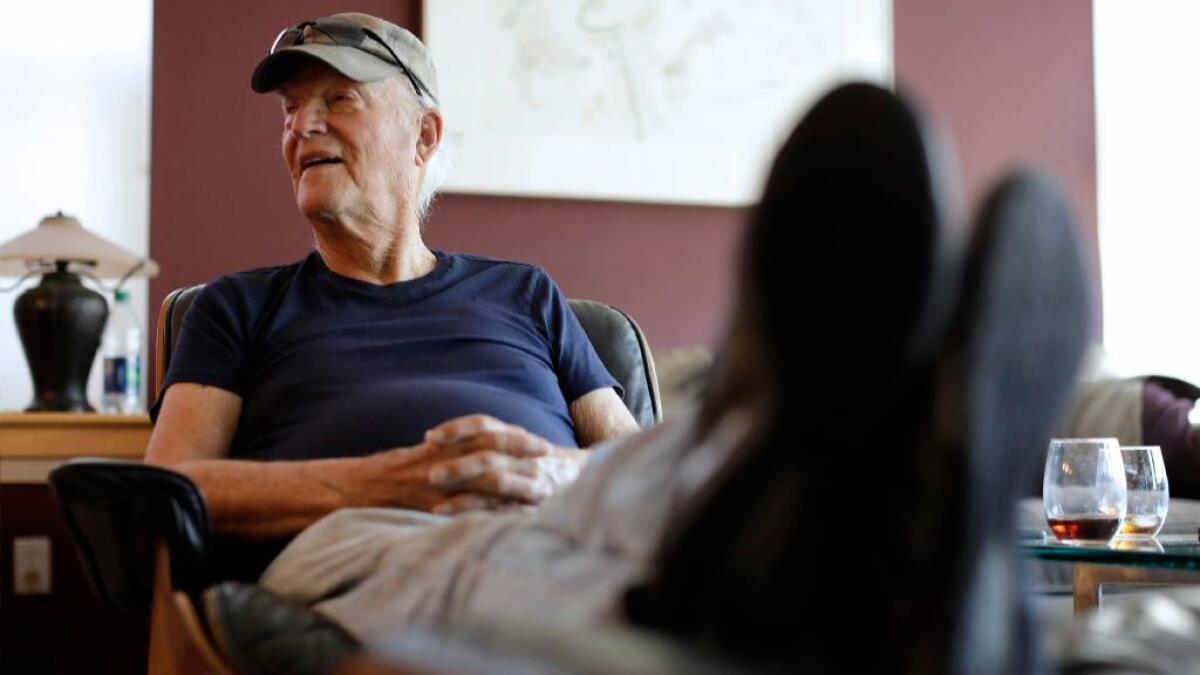
Inside a gleaming San Diego tract home, 89-year-old artist Robert Irwin reclines in his favorite leather lounge chair, snug in his favorite worn baseball cap, sipping a fizzy Coke over ice.
Irwin has lived here about 15 years “because my wife wanted kids on the block for our daughter,” he says of his now 23-year-old. Still, the cozy setting seems incongruous. With dark sunglasses donned and legs outstretched, Irwin appears less the renowned contemporary artist that Los Angeles County Museum of Art Director Michael Govan calls one of the most innovative artists of the ’60s and ’70s and more a relaxed suburbanite, tanned and ruggedly handsome.
But Irwin’s minimalist, site-specific installations toy with the viewer’s sense of perception, and if you look more closely here, his home reveals Irwin-esque touches everywhere — beauty in the benign. Sunlight seeps in through glass panes, apropos for a California Light and Space artist; nearly every window has views of his wife’s garden, nodding to Irwin’s love of artful plantings, like his Central Garden at the Getty Center; the elongated entrance hallway features a stark wall cutout offering a peek of the sky. And the chair? It’s a Charles and Ray original that Irwin bought in the ’60s from the Eameses themselves, back when his studio was in Venice near theirs.
“Beauty is all around you,” he says. “You open your eyes in the morning, the world is totally formed. You haven’t done anything other than be. It’s all around you. The whole idea is being able to recognize it, and pay attention to it, articulate it.”
Irwin is still recognizing, and the world is still paying attention — with a gallery exhibition of new work and a museum survey focused on his planning process as well as new or evolving projects for the Academy Museum and LACMA. All of which, he’s humbly matter-of-fact about: “Am I having a moment? No. I’ve been here all my life.”
Since abandoning the confines of his art studio in 1970 — and the contained, two-dimensional, abstract expressionist paintings he made there — in exchange for more expansive environments that played with light, space and color, “beauty in the benign” has been a guiding principal for Irwin. That could mean a reimagined, dilapidated building in Marfa, Texas; strategically placed palm trees on LACMA’s campus; or, simply, daylight flowing through a rectangular cutout in a concrete wall sculpture. His “site conditional” works, as he calls them, don’t necessarily impose a vision upon the spaces they inhabit as much as respond to them, guiding the viewer through and “opening their eyes to the beauty that’s already there,” he says. “Snapping their garter.”
Three years ago, Irwin found beauty in a gallery, Sprüth Magers, then under construction on Wilshire Boulevard. Senior director Sarah Watson was a friend who had shown Irwin’s work at the now defunct L&M Arts in 2011 — the last time Irwin exhibited large-scale work in Los Angeles. He stopped by to view the new space and was smitten with the soaring windows and the sunlight bouncing off the concrete floors, not to mention the surrounding streetscape. He was appalled, though, at the interior walls that were going up to display artists’ work.
“Why in the world would you take a room that had that much beautiful light and put walls up?” he says. “So I took the walls down. What does that mean? It lets the outside world in. So now the whole thing becomes an interaction with the quality of that space.”
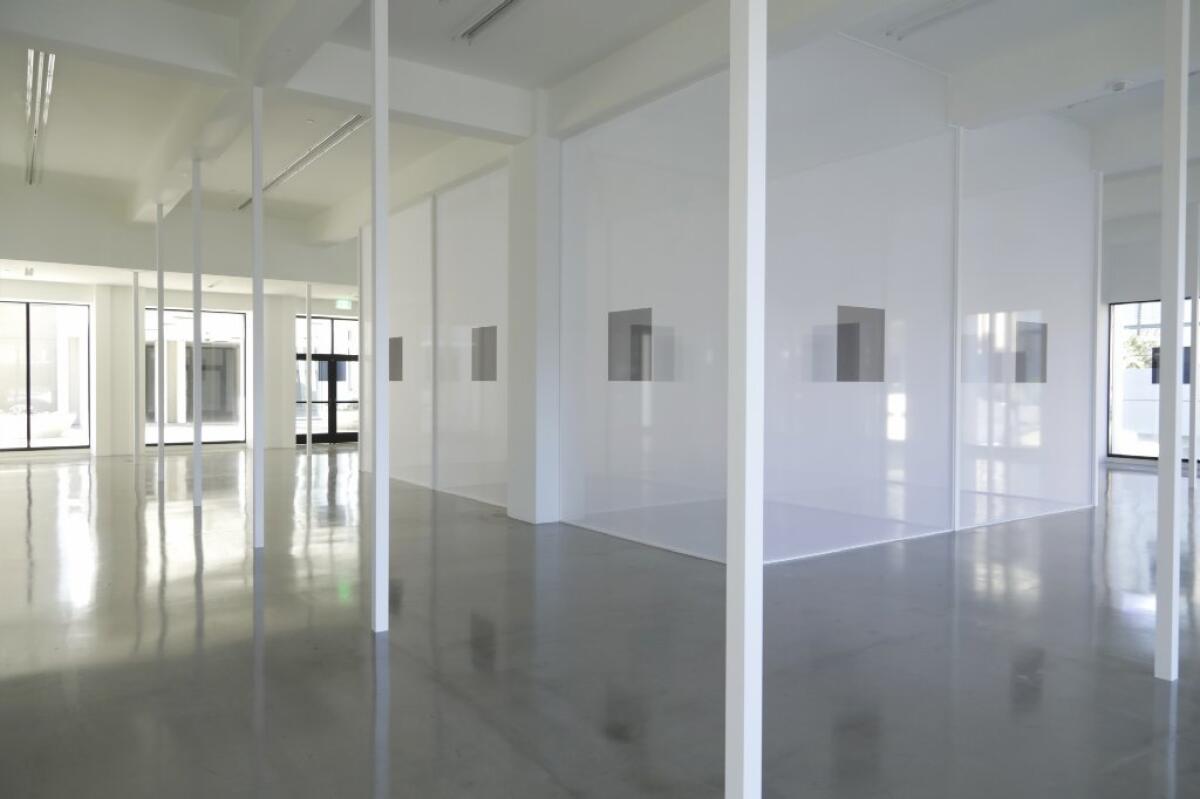
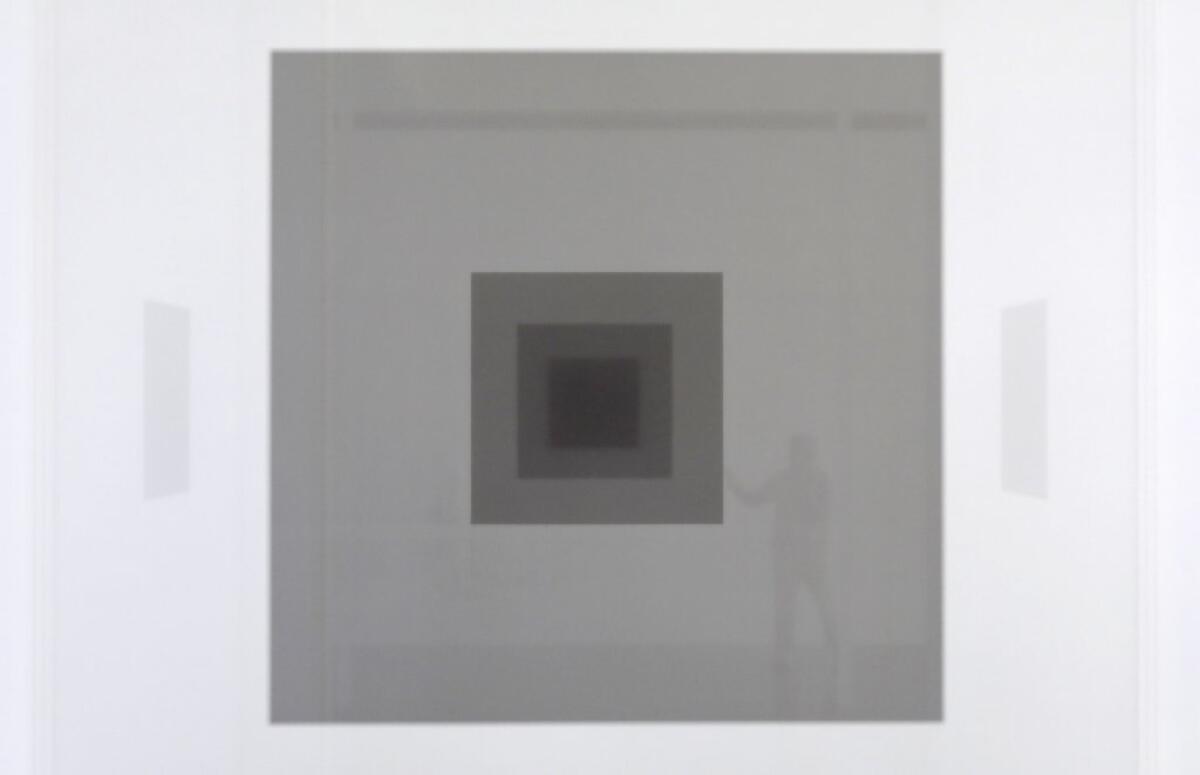
His affection for the gallery and its surrounding outdoor environment resulted in a new, immersive installation that debuted there Jan. 23. The work — six 10-foot-square white-scrim chambers featuring spray-painted squares and surrounded by tinted window squares or lacquered square wall paintings — takes over the entire ground floor of Sprüth Magers. The gallery cleared all but one interior wall on that level to make room for the piece and changed operating hours because the installation is meant to be viewed only in daylight, its angles and shadows shifting with the sun.
The effect is ethereal and elegant, if deceptively simplistic at first, a geometric maze of gauzy-looking cubes housing receding images of squares that are translucent head on but jet black from the side. Passersby cast fleeting, ghostly silhouettes that seem to float around the piece. But, like a freshly snapped Polaroid slowly pulling into focus, over time, geometric strategy and artistic rigor emerge. Pillars and squares delineate precise horizontal and vertical axes.
A square on the north wall aligns with a square window on the façade of LACMA, across the street. It draws the viewer’s eye outside, extending the work to include life on the sidewalk. Glimpses, through the scrim, of the lacquered squares on the lone interior wall nod, teasingly, at the gallery’s obliterated walls and the paintings that once hung there.
Govan, whose relationship with Irwin dates back to the mid-’90s, says the work poses more questions than answers.
“He’s a person who doesn’t just make objects to marvel at but inspires self-questioning of the status of objects, the essence of modernity. He’s deeply philosophical,” Govan says. “The work asks questions about what you’re seeing — he often puts you off-kilter — and that investigation you have with the work, once you feel it, you own it for yourself.”
Irwin puts it more simply: “I’m trying to make the most beautiful thing and knock your socks off. That’s it, that’s all.”
The concept can be purchased for an undisclosed price, but the piece, as installed, is not for sale, Watson says. “It’s based on the dimensions of the space,” she says. “There’s no way you could actually re-create this. You’d have to rebuild the gallery.”
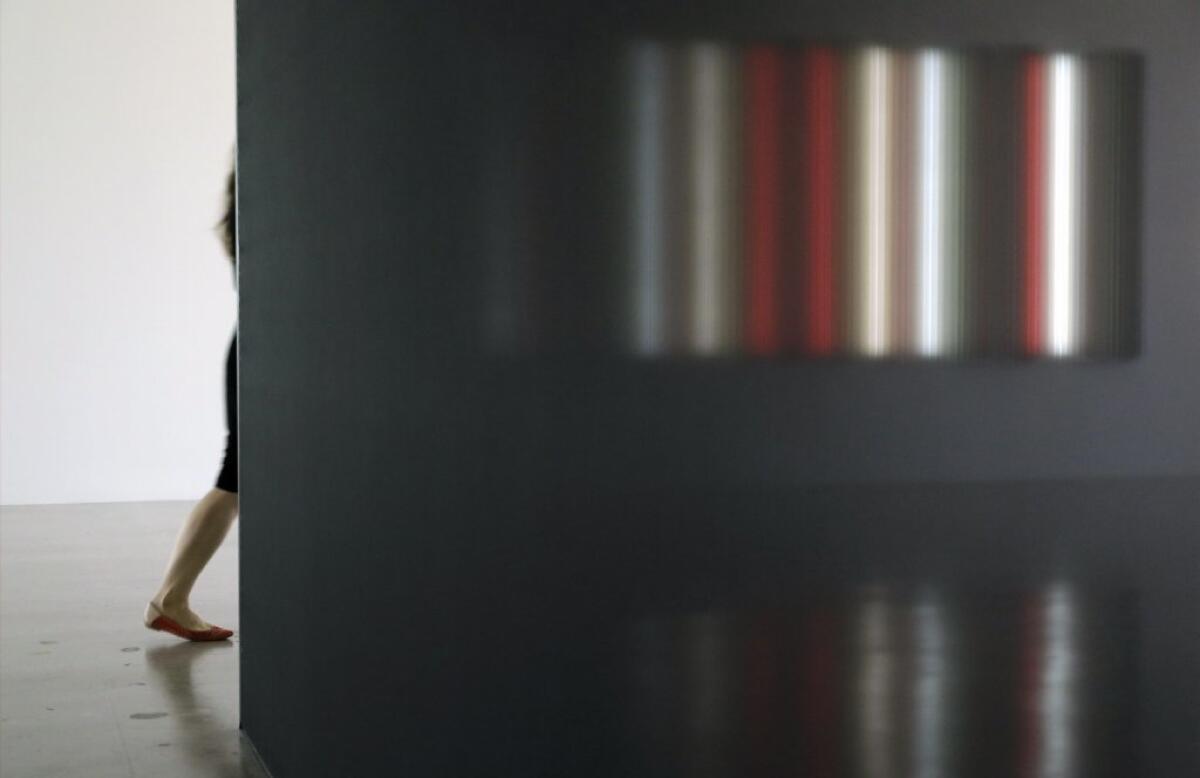
Four of Irwin’s light works are on view upstairs, a space divided by a transparent, black scrim wall. The works are vertical groupings of fluorescent tubes that Irwin wrapped with richly colored theatrical gels. Electrical tape on the outside of the tubes creates both delicate and thicker line work. Each piece has a distinct color palette: One is jewel-toned, another cool and sea-foamy. Through the reflections and refractions they cast, Irwin is, in a sense, “painting with light,” he says.
“If you’ve been a painter, you learn all these things about how colors act and interact with each other. Here, we’re playing with light.”
A new survey exhibition of more than four decades of Irwin’s planning materials sheds light on his creative process. “Robert Irwin: Site Determined” opened at Cal State Long Beach’s University Art Museum on Jan. 29.
The exhibition, curated by Irwin scholar and art history professor Matthew Simms, includes Irwin’s architectural drawings, models, photo grids showing ideas for plant materials and water features — “the kinds of things that get rolled up and put away once the board room conversations are over and the final project is realized,” Simms says.
“My idea was to bring out the way in which Irwin works through and presents ideas with the medium of drawing as a way to develop consensus and communicate with collaborators and other invested parties as he worked on large and ambitious projects.”
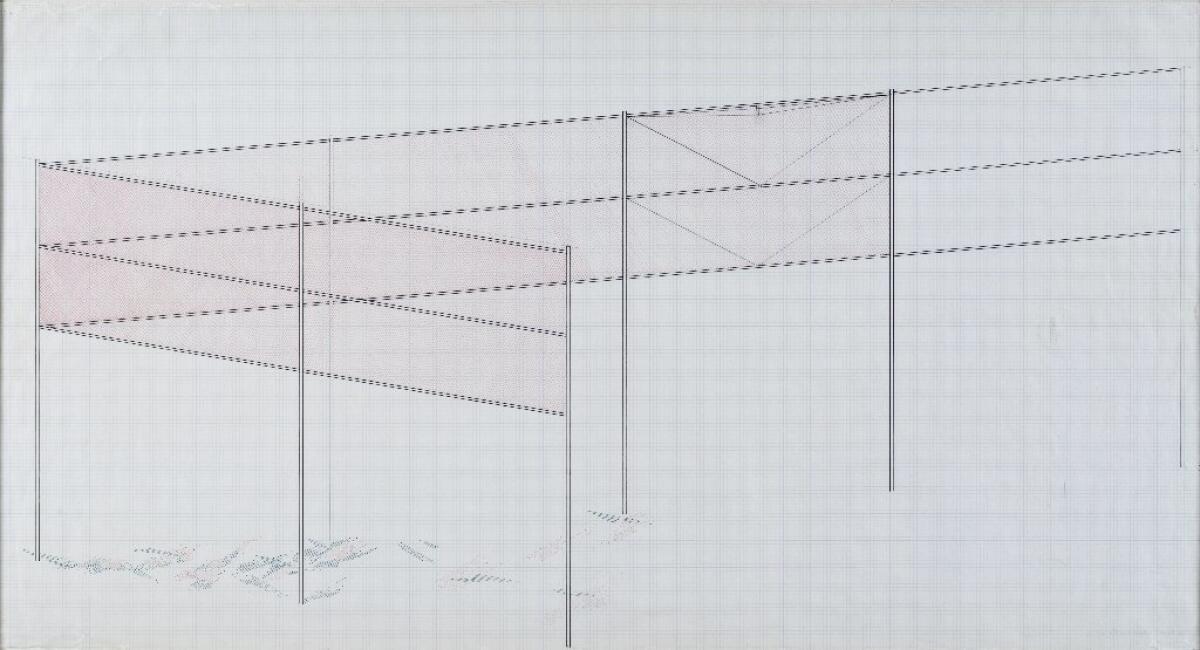
About a third of the exhibition is devoted to Irwin’s 2016 “Untitled (dawn to dusk),” at the Chinati Foundation in Marfa. Irwin transformed an abandoned U-shaped hospital building using black and white scrim, turning it into a vessel of sorts that responds to the shifting and changing light. The show also includes early plans for Irwin’s Central Garden at the Getty, which opened in 1997, and an unrealized project from the ’80s in which Irwin questions the role that public art could take at the Miami International Airport.
Irwin’s “Window Wall” — his first outdoor sculpture, which has been on view at the university since 1975 — was conserved in conjunction with the exhibition. The white wall with a rectangular cut out frames a view of the campus quad. The museum will provide maps to the artwork, so that visitors can take self-guided tours, putting a fine point on what Simms calls “a master class in Irwin’s site-determined art.”
An office nook in Irwin’s home is alive with such process materials for upcoming projects. Printouts of multicolored succulents and swaths of cracked earth are tacked to the wall, and rolled up architectural drawings blanket his desk.
I made plans, but nobody’s taken interest in them yet. Nobody wants to let me play.
— Robert Irwin on his ideas for the La Brea Tar Pits
Irwin says he’s developing a plant-based work for the new Academy Museum, possibly a small garden, which would be an extension of the ideas in his “Primal Palm Garden” at LACMA next door. When the Academy Museum is finished, he’ll create new plantings on LACMA’s campus to give the two works cohesion.
And if he had his druthers, he’d extend the work to the La Brea Tar Pits. “Amazing place, totally primitive explosion of tar,” he says. “But when you go there, it looks pretty dull. A little bubbling. A couple of concrete elephants. What I’d like to do is make it much more dramatic, do a kind of planting that’s more gripping. I made plans, but nobody’s taken interest in them yet. Nobody wants to let me play.”
He’s also working on a proposed a project for the Château La Coste vineyard in the South of France, a long mulled idea to carve “five black holes” in a small lake with silicon bronze. “No body’s ever done anything like that,” he says.
Talking about the new work, Irwin’s eyes gleam. One eyelid hangs low from a recent surgery. He has glaucoma and has had several surgeries over the past few years. But his sight is good enough, he says; he still works regularly, attuned to the subtleties of the spaces he inhabits.
And if he can open your eyes too, then he’s done his job.
“What I just did, as far as I’m concerned, has to do with feelings,” he says of the Sprüth Magers installation. “Theoretically, it makes you really aware of how [darn] beautiful the world is, how interesting it is.”
He savors a sip of cola, before a teasing smile appears on his face.
“If it snaps my garter, I figure somebody else will find it interesting. Maybe it’ll snap their garter too.”
Follow me on Twitter: @debvankin
UPDATES:
4:06 p.m.: This article was updated to reflect the gallery’s evolving approach to selling the work.
The biggest entertainment stories
Get our big stories about Hollywood, film, television, music, arts, culture and more right in your inbox as soon as they publish.
You may occasionally receive promotional content from the Los Angeles Times.




